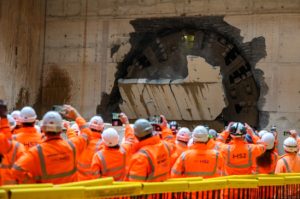The boring machine being used to dig HS2’s Birmingham approach tunnels has broken through, marking the completion of major tunnel excavation between London’s Old Oak Common and the West Midlands — a significant step forward for the UK’s most ambitious rail infrastructure project.
The 125-metre-long tunnel boring machine (TBM), Elizabeth — named after 19th-century philanthropist Elizabeth Cadbury — was launched near the Warwickshire village of Water Orton in March 2024. It arrived at Washwood Heath this morning, completing its 3.5-mile journey beneath the M6 and eastern outskirts of Birmingham.

Completing the Birmingham Approach Tunnels
Elizabeth is one of two identical machines used to construct the twin-bore Bromford tunnel. The first TBM, Mary Ann, completed its breakthrough earlier this year. Together, the two machines have excavated more than 1.8 million tonnes of material and installed 5,804 concrete ring segments to line the eastbound and westbound tunnels.
The excavated material — largely Mercia Mudstone — is being reused to landscape the railway’s approach to the city, supporting the project’s commitment to sustainability and responsible material use.
Today’s milestone means all deep-bore tunnelling is now complete for the 28 miles between Old Oak Common in west London and Birmingham Curzon Street. Construction teams are now focusing on internal walkways, ventilation shafts, and cross passages.
Once operational, HS2 will deliver faster, more reliable journeys between London and Birmingham, while freeing up capacity on the existing West Coast Main Line for additional local and freight services.
A Milestone for the Industry
Alan Morris, HS2 Ltd’s Construction Delivery Director, said:
“Today’s breakthrough is a major milestone for the tunnelling team here in Birmingham and for the HS2 project. All eight of the TBMs digging our tunnels between Old Oak Common and Curzon Street have now broken through, which means that the focus is now on the internal concrete work, ventilation shafts and cross passages.
I’m immensely proud of the men and women who have worked round the clock to bring our TBMs and their crews home safely, and I look forward to seeing more progress inside the tunnels in the years ahead.”
Each TBM functions as a self-contained underground factory — excavating, installing, and sealing concrete ring segments as it advances, typically progressing around 10 metres per day.
So far, eight TBMs have been deployed on the project, excavating 9.4 million tonnes of material. The network of tunnels includes:
-
The Chiltern Tunnel – 10 miles, the longest on the route
-
Northolt Tunnels – 8.4 miles from West Ruislip to Old Oak Common
-
Bromford Tunnel – 3.5 miles to the east of Birmingham
-
Long Itchington Wood Tunnel – 1 mile twin bore
Two further TBMs are due to launch next year to begin tunnelling from Old Oak Common to London Euston. In addition, a short mined section is underway between the Victoria Road Crossover Box and Old Oak Common, while around 5 miles of shallow ‘cut-and-cover’ tunnels are being delivered in areas such as Burton Green, Chipping Warden, and Wendover.
Over the 18-month operation, teams navigated challenging conditions at depths of up to 40 metres — driving beneath the M6 motorway, key National Grid infrastructure, and crossing the River Tame four times with as little as five metres of clearance.
As Elizabeth completes her mission, work now turns to concrete finishing, base slabs, and the installation of emergency and maintenance walkways.
The completion of the Birmingham approach tunnels represents more than a technical achievement — it is a symbol of progress toward a better connected, higher-capacity national rail network that will serve passengers, freight, and communities for generations to come.